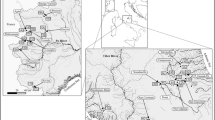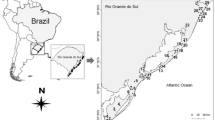Abstract
Submerged macrophytes are important components of wetland ecosystems in the Prairie Pothole Region of North America, but factors influencing species abundance and community structure are poorly known. We sampled submerged macrophyte communities and habitat characteristics in 18 prairie wetlands for five years in order to 1) assess interspecific relationships between macrophyte species, 2) test for presence of distinct species assemblages at the whole-basin level, and 3) identify relationships between community composition and limnological characteristics of the wetland basins. Macrophyte communities did not occur as distinct assemblages of species; most species showed eurytopic distributions, and communities varied along gradients of individual species abundances. Redundancy analysis showed that turbidity, presence/ absence of fish, drainage history (restored versus non-drained), average depth, and surface area explained 20% of the variance in species abundance. However, turbidity and drainage history alone accounted for 15% of this variance. Most species showed a negative relationship with turbidity, while drainage history influenced community composition but had little effect on overall abundance at the community level. Our results indicate that restored and non-drained wetlands have similar species richness but differ in species composition. Species richness and total plant abundance in both restored and non-drained wetlands will be greatest in wetlands with low turbidity, moderate depth, and small surface area. However, substantial residual variation indicates that additional, unstudied factors are important determinants of community structure.
Similar content being viewed by others
Literature Cited
Asaeda, T., V. Kien Trung, and J. Manatunge. 2000. Modeling the effects of macrophyte growth and decomposition on the nutrient budget in shallow lakes. Aquatic Botany 68:217–237.
Batt, B. J., M. G. Anderson, C. D. Anderson, and F. D. Caswell. 1989. The use of prairie potholes by North American ducks. p. 204–227.In A. G. van der Valk (ed.) Northern Prairie Wetlands. Iowa State University Press, Ames, IA, USA.
Borcard, D., P. Legendre, and P. Drapeau. 1992. Partialling out the spatial component of ecological variation. Ecology 73:1045–1055.
Carpenter, S. R. and D. M. Lodge. 1986. Effects of submersed macrophytes on ecosystem processes. Aquatic Botany 26:341–370.
Chambers, P. A. and E. E. Prepas. 1990. Competition and coexistence in submerged aquatic plant communities: the effects of species interactions versus abiotic factors. Freshwater Biology 23:541–550.
Dahl, T. E. 1990. Wetland losses in the United States 1780's to 1980's. U.S. Fish and Wildlife Service, Washington, DC, USA.
Dahl, T. E. and C. E. Johnson. 1991. Wetland status and trends in the conterminous United States, mid 1970's to mid 1980's. U.S. Fish and Wildlife Service, Washington, DC, USA.
Depp, E. R. and R. C. Lathrop. 1992. A comparison of two rake sampling techniques for sampling aquatic macrophytes. Wisconsin Department of Natural Resources, Madison, WI, USA. Management Finding No. 32.
Duarte, C. M., J. Kalff, and R. H. Peters. 1986. Patterns in biomass and cover of aquatic macrophytes in lakes. Canadian Journal of Fisheries and Aquatic Sciences 43:1900–1908.
Dufrene, M. and P. Legendre. 1997. Species assemblages and indicator species: the need for a flexible asymmetrical approach. Ecological Monographs 67:345–366.
Galatowitsch, S. M. and A. G. van der Valk. 1996a. The vegetation of restored and natural prairie wetlands. Ecological Applications 6:102–112.
Galatowitsch, S. M. and A. G. van der Valk. 1996b. Vegetation and environmental conditions in recently restored wetlands in the prairie pothole region of the USA. Vegetatio 126:89–99.
Hansel-Welch, N., M. G. Butler, T. J. Carlson, and M. A. Hanson. 2001. Ten years of plant community change following biomanipulation of a large shallow lake. Verhandlungen International Vereinigung Limnologie 27:3465–3469.
Hanson, M. A. and M. G. Butler. 1994. Responses of plankton, turbidity, and macrophytes to biomanipulation in a shallow prairie lake. Canadian Journal of Fisheries and Aquatic Sciences 51: 1180–1188.
Hanson, M. A. and M. R. Riggs. 1995. Effects of fish predation on wetland invertebrates: a comparison of wetlands with and without fathead minnows. Wetlands 15:167–175.
Hanson, M. A., K. D. Zimmer, M. G. Butler, B. A. Tangen, and E. H. Euliss, Jr. Biotic interactions as determinants of ecosystem structure in prairie wetlands. Submitted to Wetlands.
Kantrud, H. A. 1990. Sago pondweed (Potamogeton pectinatus L.): a literature review. U.S. Fish and Wildlife Service, Washington, DC, USA. Resource Publication Number 176.
Kantrud, H. A., G. L. Krapu, and G. A. Swanson. 1989. Prairie basin wetlands of the Dakotas: a community profile. U.S. Fish and Wildlife Service. Washington, DC, USA. Biological Report Number 85 (7.28)
LaGrange, T. G. and J. J. Dinsmore. 1989. Plant and animal community responses to restored Iowa wetlands. Prairie Naturalist 21:39–48.
Lougheed, V., B. Crosbie, and P. Chow-Fraser. 2001. Primary determinants of macrophyte community structure in 62 marshes across the Great Lakes basin: latitude, land use, and water quality effects. Canadian Journal of Fisheries and Aquatic Sciences 58:1603–1612.
Ludwig, J. A. and J. F. Reynolds. 1988. Statistical Ecology: a Primer on Methods and Computing. John Wiley and Sons, New York, NY, USA.
McCune, B. and M. J. Mefford. 1997. PC-ORD. Multivariate Analysis of Ecological Data, Version 3.0. MjM Software Gleneden Beach, OR, USA.
Moss, B., J. Madgwick, and G. Phillips. 1996. A Guide to the Restoration of Nutrient-Enriched Shallow Lakes. Broads Authority, Norwich, England.
Rose, C. and W. G. Crumpton. 1996. Effects of emergent macrophytes on dissolved oxygen dynamics in a prairie pothole wetland. Wetlands 16:495–502.
Scheffer, M. 1998. Ecology of Shallow Lakes. Chapman and Hall, London, England.
Schluter, D. 1984. A variance test for detecting species associations, with some example applications. Ecology 65:998–1005.
Spence, D. H. N. 1982. The zonation of plants in freshwater lakes. p. 37–125.In A. Macfadyen and E. D. Ford (eds.) Advances in Ecological Research. Academic Press, London, England.
Stewart, R. E. and H. A. Kantrud. 1971. Classification of natural ponds and lakes in the glaciated prairie region. U.S. Fish and Wildlife Service, Washington, DC, USA. Resource Publication 92.
ter Braak, C. J. F. 1994. Canonical community ordination. Part 1: basic theory and linear methods. Ecoscience 1:127–140.
ter Braak, C. J. F. 1995. Ordination. p. 91–173.In R. H. G. Jongman, C. J. F. ter Braak, and O. F. R. van Tongeren (eds.) Data Analysis in Community and Landscape Ecology. Cambridge University Press, Cambridge, England.
ter Braak, C. J. F. and P. F. M. Verdonschot. 1995. Canonical correspondence analysis and related multivariate methods in aquatic ecology. Aquatic Sciences 57:255–289.
ter Braak, C. J. F. and P. Smilauer. 1998. CANOCO Reference Manual and User's Guide to Canoco for Windows: Software for Canonical Community Ordination, Version 4 Microcomputer Power, Ithaca, NY, USA.
Timms, R. M. and B. Moss. 1984. Prevention of growth of potentially dense phytoplankton populations by zooplankton grazing, in the presence of piscivorous fish, in a shallow wetland ecosystem. Limnology and Oceanography 29:472–486.
Titus, J. E. and M. D. Stephens. 1983. Neighbor influences and seasonal growth patterns forVallisneria americana in a mesotrophic lake. Oecologia 56:23–29.
van der Valk, A. G. and C. B. Davis. 1976. Changes in the composition, structure, and production of plant communities along a perturbed wetland coenocline. Vegetatio 32:87–96.
van Tongeren, O. F. R. 1995. Cluster analysis. p. 174–212.In R. H. G. Jongman, C. J. F. ter Braak, and O. F. R. van Tongeren (eds.) Data Analysis in Community and Landscape Ecology. Cambridge University Press, Cambridge, England.
Vestergaard, O. and K. Sand-Jensen. 2000. Aquatic macrophyte richness in Danish lakes in relation to alkalinity, transparency, and lake area. Canadian Journal of Fisheries and Aquatic Sciences 57: 2022–2031.
Walker, B. H. and C. F. Wehrhahn. 1971. Relationships between derived vegetation gradients and measured environmental variables in Saskatchewan wetlands. Ecology 52:85–95.
Wilcox, D. A. and J. E. Meeker. 1991. Disturbance effects on aquatic vegetation in regulated and unregulated lakes in northern Minnesota. Canadian Journal of Botany 69:1542–1551.
Zimmer, K. D., M. A. Hanson, and M. G. Butler. 2000. Factors influencing invertebrate communities in prairie wetlands: a multivariate approach. Canadian Journal of Fisheries and Aquatic Sciences 57:76–85.
Zimmer, K. D., M. A. Hanson, and M. G. Butler. 2001a. Effects of fathead minnow colonization and removal on a prairie wetland ecosystem. Ecosystems 4:346–357.
Zimmer, K. D., M. A. Hanson, M. G. Butler, and W. G. Duffy. 2001b. Influences of fathead minnows and aquatic macrophytes on nutrient partitioning and ecosystem structure in two prairie wetlands. Archiv für Hydrobiologie 150:411–433.
Zimmer, K. D., M. A. Hanson, and M. G. Butler. 2002. Effects of fathead minnows and restoration on prairie wetland ecosystems. Freshwater Biology 47:2071–2086.
Author information
Authors and Affiliations
Rights and permissions
About this article
Cite this article
Zimmer, K.D., Hanson, M.A. & Butler, M.G. Interspecies relationships, community structure, and factors influencing abundance of submerged macrophytes in prairie wetlands. Wetlands 23, 717–728 (2003). https://doi.org/10.1672/0277-5212(2003)023[0717:IRCSAF]2.0.CO;2
Received:
Revised:
Accepted:
Issue Date:
DOI: https://doi.org/10.1672/0277-5212(2003)023[0717:IRCSAF]2.0.CO;2




